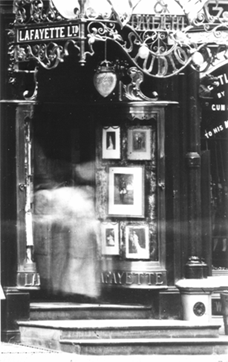Introduction
|
Detail of the entrance to the Lafayette Studio, circa 1913 |
The Lafayette studio has one of the oldest histories of any photographic business in the world. During its peak years, the studio photographed a succession of King Emperors, Queen Empresses, Viceroys and Vicereines as well as visiting royalties from Europe, Africa and Asia.
Lafayette was founded in Dublin in 1880 by James Stack Lauder, who used the professional name of James Lafayette (‘late of Paris’, as his own firm’s publicity billed him). James was the eldest son of Edmund Lauder, a pioneering and successful photographer who had opened a daguerreotype studio in Dublin in 1853.
The new business flourished from the start. It soon established itself as the premier portrait studio in Ireland following commissions from the Viceroy and leading members of the Irish aristocracy. During the 1880s the studio started amassing medals and prizes for its fine photographic work with comments such as these coming from the Photographic Society of Great Britain: “M[onsieur] Lafayette's pictures also the judges considered very beautiful, being distinguished for delicacy of treatment...”
The firm’s reputation as portrait photographers was such that in 1887 James Lafayette was invited to Windsor to photograph Queen Victoria and was granted a Royal Warrant as ‘Her Majesty’s Photographer in Dublin’.
This Royal Warrant, which was subsequently renewed by King Edward VII and George V, conferred enormous prestige. The style and title of ‘Photographer Royal’, which now appeared on the studio advertising and promotional literature, proved extremely useful in attracting new clients. In 1897, the year of Queen Victoria’s Diamond Jubilee, James Lafayette opened his first studio on London’s fashionable Bond Street in an attempt to capitalise on the expected commercial bulge.
The Lafayette studio finally closed in 1952 having produced photographs continuously from 1853. They also kept an archive of the company’s most important negatives, almost all of which were marked with the name of the sitter and the date when the negative was made. This storeroom of negatives ended up relegated in the attic of a building in Fleet Street and was not discovered until 1968 during building works. They finally were handed to the Victoria & Albert Museum, London, which kept 3,500 glass plate and celluloid negatives dating from 1885 to c 1937.
Even though enormous numbers of photographs of the early motor cars were published in the illustrated press in the years before 1905, very few original negatives have survived. To a much greater degree than any other studio, Lafayette captured the rise of the motor car due to his close collaboration with John Scott Montague (later Lord Montague of Beaulieu), car enthusiast, founder and editor of The Car Illustrated. Lafayette assisted the magazine munificently in its first few years of existence, supplying for its covers and inside articles a new type of photographic portrait – showing the proud owners (many of who sat for him previously on different occasions) at the wheel of their new vehicle, as well as images of their country houses, for feature stories promoting the motor car as a means of travelling around the country and of visiting hitherto unreachable national treasures.

King Edward VII’s new 22 bhp Daimler,
photographed by Lafayette
at Windsor Castle, June 1902.

